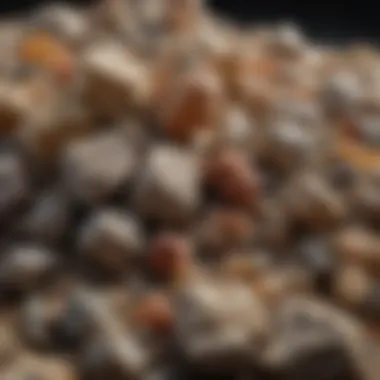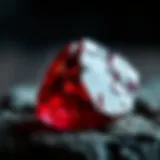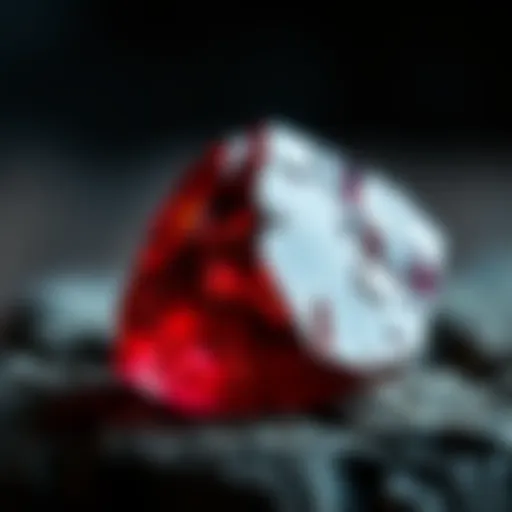Mastering Lortone Rock Tumbler Grit Techniques


Intro
Lortone rock tumblers hold a special place in the hearts of many rock and fossil collectors. These machines are more than just contraptions for polishing; they serve as gateways into a world of geological wonders. With the right grit, a rock can transform from a dull, unexciting piece into a dazzling gemstone that tells a story. Understanding the different types of Lortone tumbler grit is crucial for anyone interested in this hobby. Whether you’re a novice or seasoned collector, knowing how to choose and use the right grit can significantly impact your results.
History and Origins
Before diving into the specifics of Lortone rock tumbler grit, it's essential to touch on the broader context of collectibles like rocks and fossils. This practice can be traced back thousands of years. Ancient cultures prized gemstones, with some even using them as currency or for spiritual purposes.
Overview of Collectibles, Rocks, and Fossils
The journey of rock collecting is as diverse as the stones themselves. From Native American tribes that utilized stones in various crafts to Renaissance collectors who sought after rare minerals, the significance of these natural wonders cannot be understated. Collecting rocks and fossils is not just a pastime; it’s a tangible connection to the Earth’s history. Many collectors start with a simple interest in nature, but soon find themselves engrossed in the complexities of geology.
Historical Significance and Cultural Impact
Throughout history, different societies have recognized the value and beauty of rocks. The Egyptians, for example, used lapis lazuli in jewelry and artifacts, forming a connection between the earth and their spiritual beliefs. Similarly, in the Americas, the indigenous people crafted tools and ornaments from stones, effectively honoring their natural surroundings. Thus, the significance of rocks and fossils extends far beyond mere aesthetics; they embody heritage and culture.
Identification and Classification
For any collector, being able to identify and classify different types of rocks and fossils is a fundamental skill. Understanding how to categorize these treasures can aid in selecting the appropriate grit for tumbling.
Guide to Identifying Rocks and Fossils
When you come across an interesting piece, consider its texture, color, and any notable features. Familiarize yourself with common types:
- Igneous: Formed from cooled magma or lava. Think basalt or granite.
- Sedimentary: Made from particles that have cemented together over time, such as limestone.
- Metamorphic: Rocks that have changed forms due to heat and pressure, like marble.
Learning these characteristics allows enthusiasts to classify their finds and understand the best tumbling practices.
Common Types and Variations
Different rocks require different levels of grit for polishing. Here are some common types you might encounter while hunting:
- Amethyst: Known for its purple hues, it’s a popular choice among collectors.
- Jasper: This variety comes in many patterns and colors, often rich in history.
- Agate: Characterized by its intricate bands, it can be quite stunning when polished.
Knowing the specific needs of each stone aids in selecting the correct Lortone grit, ensuring the best outcome in your polishing ventures.
“Choosing the right grit is like selecting the best tool for the job; it can make all the difference.”
Through understanding these foundational elements of rock collecting and tumbling, readers can better appreciate the nuances involved in polishing techniques and grit selection.
Preamble to Rock Tumbling
Rock tumbling is more than just a hobby; it's a journey into the earth's hidden beauty. It’s like peeling back the layers of an onion, only the core is often a stunning gem waiting to be revealed. Understanding the basics of rock tumbling sets the stage for every enthusiast, from the novice to the seasoned collector. This section will dive into what rock tumbling entails and why having a solid grasp on it is essential for success.
The Art and Science of Rock Tumbling
At first glance, rock tumbling might seem straightforward. Toss a few stones into a barrel, add some grit, and let the machine do its thing. However, there’s an interesting interplay of art and science at play here. The science comes in with the materials involved: the types of rocks, the grits, and the tumbling techniques. Choosing the right grit matters; not all grits are created equal, and using the wrong one could spell disaster for your rocks. On the artistic side, it’s about the vision you hold for the final product. The shiny, polished stones you want to create require attention to detail and a bit of patience.
Understanding how different grits work together in the tumbling process is akin to knowing how different colors react on a painter’s palette. Each step of the tumbling process helps bring out unique characteristics in your stones. It is this blend of methodology and intuition that makes rock tumbling both an art and a science. It’s an exploration of possibilities, where each batch of stones can yield vastly different results based on your choices.
Overview of Rock Tumblers
Rock tumblers are the machines that transform rough stones into polished gems. Not all tumblers are built alike, and selecting the right tumbler is crucial. Generally, they come in various sizes, capacities, and designs, each catering to the needs of different rock tumbling enthusiasts. Some people might prefer a smaller tumbler for a more personal project, while others need larger machines to accommodate their larger collections of stones.
Typically, rock tumblers consist of a rotating barrel where rocks and grit mix together. The rotation mimics the natural processes that occur over thousands of years in rivers and streams, polishing rocks to a lustrous finish. In essence, tumblers make it possible for anyone to engage in this time-honored practice without waiting decades for nature to work its magic.
Considering factors such as durability, power source, and noise levels is vital when choosing a tumbler. Moreover, an understanding of how rock tumblers operate can significantly improve the outcome of your polishing efforts. The right tumbler, paired with the appropriate grit, can make all the difference in your rock tumbling journey.
"The act of transforming stones is not just about finishing; it's about learning patience and craftsmanship."
Lortone Tumblers: An Overview
The world of rock tumbling is vast, yet a few brands manage to stand out due to their quality and reliability. One such brand is Lortone, known for crafting tumblers that enthusiasts trust and prefer. Understanding Lortone tumblers offers insight into what makes them a favorite among rock and mineral collectors. Effective polishing hinges on the right tools, and Lortone has honed its methods over years of dedicated craftsmanship.
These tumblers are designed not only to simplify the rock polishing process but also to offer consistent results. For many rockhounds, the decision to use Lortone tumblers stems from their quality components and innovative designs. Achieving a beautiful finish on stones becomes less of a chore and more of a rewarding experience when you have the right equipment.


History and Development
Lortone has a rich history that traces back to the mid-20th century. It was in 1957 that the company began its journey in the tools and equipment industry, with a focus on rock tumbling. The original founders recognized a gap in the market for reliable and durable tumblers. They set out to create devices that could withstand the rigors of repeated use while delivering superior polishing results.
Over the decades, Lortone has continuously improved its products. From evolving the design to enhancing the materials used in construction, they’ve kept pace with advancements in technology while maintaining an easy-to-use interface for newcomers. Most Lortone tumblers today feature improved motor technology, which reduces noise and increases lifespan, making the entire experience more enjoyable for users. This commitment to quality and innovation has solidified Lortone's position as a trusted name in the rock tumbling community.
Popular Models
Lortone offers a variety of models, accommodating different needs and preferences. Here are a few notable mentions:
- Lortone 3A: One of their best-selling models, ideal for beginners. It features a 3-pound capacity, allowing you to batch process smaller stones effectively. The quiet operation and robust motor make it perfect for indoor use.
- Lortone 33B: A larger option, this tumbler can hold up to 3 pounds in each barrel. It’s designed for more serious hobbyists who wish to polish larger quantities of rock. Its dual-barrel setup increases efficiency, allowing you to work on multiple types at once.
- Lortone QT-12: This top-of-the-line model is equipped with a heavy-duty motor, capable of handling 12 pounds of rock. The QT-12 is great for advanced collectors who require a reliable machine for extensive polishing tasks.
Considerations When Choosing a Model
When selecting the right Lortone tumbler for your needs, consider factors like the quantity of rocks you wish to polish, your experience level, and your budget. Each model has distinct features that cater to a range of requirements. In this way, Lortone ensures there's an option available for everyone, from novices to seasoned pros looking to refine their collection.
"Quality tools lead to quality results; that’s the mantra of every successful rock tumbling enthusiast."
In sum, delving into the history and popular models of Lortone tumblers highlights their commitment to both functionality and user satisfaction. Understanding these elements lays the groundwork for effectively using their grit and ensuring successful polishing endeavors.
Understanding Rock Tumbler Grit
Understanding rock tumbler grit is an essential part of the rock polishing hobby, especially when it comes to using Lortone tumblers. The right grit can make all the difference between a polished rock that looks like a gem and one that appears dull and lifeless. It's important to grasp why different types of grit are used in various stages of the tumbling process.
Using the proper grit helps in achieving the desired finish more efficiently. Each type of grit focuses on a unique aspect, whether it’s removing sharp edges, smoothing surfaces, or adding that final luster. This variety leads to not only better results but also enhances the enjoyment of the entire tumbling experience.
What is Rock Tumbler Grit?
Rock tumbler grit refers to abrasive materials used in tumbling machines to polish and shape stones. It comes in various sizes and formulations, primarily designed to gradually wear down the rough surface of the stones until a smooth finish is achieved. Traditionally made from silicon carbide or alumina, this grit can vary in coarseness, allowing you to tailor the tumbling process to your specific needs.
The grit plays a pivotal role in determining the final appearance of the rocks. The finer the grit, the smoother the finish will be. Choosing the right grit not only influences the aesthetics but also affects the time needed for polishing.
Types of Grit
Coarse Grit
Coarse grit is the starting point in most rock tumbling processes. This type of grit typically has larger abrasive particles, allowing it to effectively chip away at the rough edges and surfaces of stones. The key characteristic of coarse grit is its size, often measuring around 60 to 80 grit. This makes it a beneficial choice for initial shaping.
One unique feature of coarse grit is its ability to quickly transform a jagged rock into something more uniform. Its advantages include speed and efficiency, but it does come with the potential disadvantage of scratching softer stones if not used judiciously.
Medium Grit
Medium grit follows the coarse grit stage and serves as a transitional step. With particle sizes around 120 to 220 grit, it smoothens the surfaces further without leaving behind significant scratches. The key characteristic here is its balanced ability to refine the stones while still contributing to their overall shape.
Medium grit is popular among tumblers because it allows for effective smoothing without over-polishing. One unique feature is its versatility; it can be used on a variety of stones. However, an important consideration is the timing—overshooting this stage can lead to excessive smoothing, losing desired contours.
Fine Grit
Fine grit, usually around 500 grit, plays a critical role in the final shaping process. Its primary contribution is to enhance the polish on the rocks, refining them to a high shine. The key characteristic of fine grit is its small particle size, which provides a level of detail that previous grits lack.
What sets fine grit apart is its ability to prepare stones for polishing. It's particularly beneficial for collectors who want to display their rocks as true pieces of art. A potential downside is that it requires adequate time for the tumbling process, as rushing can hinder achieving a flawless finish.
Polishing Grit
Polishing grit is the final step in the tumbling process. Typically made of very fine particles, around 1000 grit and higher, this grit is designed purely for achieving that glass-like finish. Its importance cannot be overstated—without this crucial step, even the best-tumbled rock might appear lackluster.
The key characteristic of polishing grit is its ability to produce a mirror-like shine on properly prepared stones. Its unique feature is the range of polishing agents that can be used, such as cerium oxide or tin oxide, which offer varying results depending on the rock type. However, using polishing grit improperly or too early can lead to disappointing results, as the rocks may not have been sufficiently smoothed beforehand.
In summary, understanding rock tumbler grit is fundamental for achieving impressive results in rock polishing. Each grit type has its unique characteristics, and knowing how to select and use them effectively is key to a successful tumbling experience.
Choosing the Right Grit for Your Rocks
Selecting the proper grit for your rock tumbling project can make or break your results. The right grit can enhance the beauty of the stones, while the wrong one might lead to poor finishes or even damage. Getting this right is paramount for anyone serious about rock polishing. There are several critical factors to keep in mind when making your choice, including the type of rock, the desired finish, and the time you’re willing to commit to the tumbling process.
Factors to Consider


Type of Rock
When it comes to rock tumbling, the type of rock is perhaps the most crucial factor to consider. Different rocks possess varying hardness levels and unique characteristics that affect how they respond to tumbling. For instance, softer stones like calcite might need a gentler touch, using a finer grit sooner in the process to avoid scratching and damaging them. On the other hand, harder stones such as agate can withstand more aggressive grit without adverse effects. Knowing this distinction helps in selecting grit that complements the rock's particular traits.
In terms of popular choices, quartz emerges as a staple among enthusiasts due to its resilience and ability to achieve a high polish. However, it is imperative to approach less common types like basalt or obsidian with caution, as they may require specialized care to achieve a suitable finish without compromising their structural integrity.
Desired Finish
The finish you aim to achieve on your rocks is another essential consideration. Do you desire a gloss that reflects light or a more natural, satin feel? For a sparkling, high-gloss finish, a series of finer grits will be needed towards the end of the tumbling process. In this case, using the appropriate polishing grit after the medium and fine stages adds depth and brilliance to the stones.
Conversely, if you prefer a more subdued appearance, you might opt for an intermediate grit and skip some of the finer stages altogether. Thus, understanding the look you are aiming for helps tailor the tumbling approach. Remember, a high-gloss finish can make colors pop, while a matte finish emphasizes texture.
Time Commitment
Lastly, consider the time commitment you can dedicate to the rock polishing process. Each stage of tumbling, from coarse to fine, typically spans a week or more. If your schedule is tight, perhaps a quicker turnaround is needed, which might necessitate skipping some grit stages or using a faster polishing method. The flexibility of grit selection allows enthusiasts to adapt their tumbling regimen based on personal factors.
However, rushing through the stages could be counterproductive – rocks might not polish well, leading to unsatisfactory results. Prioritizing quality over speed is essential, yet understanding how long you can commit helps balance the quality of the finish with practical time limitations.
Common Combinations
When you're ready to begin, some common combinations of grit types can serve as a guide for your rock polishing journey. For example:
- Coarse Grit and Medium Grit: Ideal for starting with rough, unpolished rocks.
- Medium Grit and Fine Grit: A solid choice for softer stones that need a bit more care.
- Fine Grit and Polishing Grit: This is often where the magic happens, creating that polished look you seek.
By keeping in mind the type of rock, your preferred finish, and the time you have to dedicate, you can choose the right grit effectively. This way, you not only protect your investment but also ensure your rocks turn out stunning, enhancing your collection.
The Rock Polishing Process
The rock polishing process is the beating heart of effective rock tumbling. It’s not simply about throwing some rocks into a tumbler and hoping for the best; there’s a finesse to it. Each stage of polishing requires careful thought and execution. Understanding this process is crucial for achieving shiny, smooth stones that are as aesthetically pleasing as they are sentimental. It’s the journey these rocks undertake that transforms rough, unassuming pieces into stunning little gems that captivate the eye and tell a story.
Steps Involved in Tumbling
Rock tumbling is not an instantaneous affair; it is a series of steps that are interlinked in a continuous cycle. Here’s a closer look at the steps involved in the tumbling process:
- Selection of Rocks: The process begins with selecting uniform-sized rocks. Mixing mismatched sizes can lead to uneven polishing and unsatisfactory results.
- Preparation of Grit: Each stage of tumbling requires a specific type of grit. Starting with coarser grits, proceed to finer ones. The transition is crucial for a polished finish.
- Loading the Tumbler: Ensuring the tumbler is not packed too tightly allows for optimal movement of rocks and grit. The rocks should tumble freely to avoid any damage.
- Running the Tumbler: Turn it on and monitor its operation. Tumblers require time to work their magic. This duration can vary based on the rock type and size.
- Cleaning and Inspection: After each stage, clean the rocks thoroughly to remove grit and check for any imperfections. This step is essential to ensure that the next cycle is effective.
- Repeat: Depending on the desired finish, several cycles with different grit types may be necessary. It is a bit like baking; you can’t skip steps if you want a perfect result.
Timing and Duration for Each Stage
Timing is the unsung hero of rock tumbling. Each stage demands a specific duration to achieve optimal results. Here's a breakdown of the timing:
- Coarse Grit Stage: Typically lasts around 5 to 7 days. This stage involves heavy grinding that shapes the rocks and removes rough spots.
- Medium Grit Stage: This stage also takes about 5 to 7 days. It further refines the shapes while smoothing the surfaces.
- Fine Grit Stage: Generally requires another 5 to 7 days. Here, the focus shifts to polishing, gradually creating a reflective surface.
- Polishing Stage: The final short burst usually lasts 2 to 5 days. This stage brings out the shine and completes the transformation.
It’s vital to be patient. Every rock has its own personality, and those who rush the process often end up disappointed. Typically, the longer the rocks tumble through each stage, the better the end result. But balancing time with observation is key; if you see any negative changes, it might be time to adjust your strategy.
Advantages of Using Lortone Grit
Choosing the right grit for rock tumbling is pivotal to achieving stunning, polished stones. Lortone grit stands out as a top choice among hobbyists for several compelling reasons. It’s more than just a branding; it’s about the quality, efficiency, and the overall user experience that enhances the rock polishing journey.
Quality of Grit
When we talk about the quality of grit, Lortone grit shines brightly in the crowd. The company has carved out a reputation for sourcing high-grade materials that provide effective abrasion during tumbling. This quality assurance means that the grit particles are uniform and consistent, which is essential for even polishing.
Well-crafted grit results in a faster and more efficient tumbling process. For instance, using Lortone grit can reduce the number of cycles needed for achieving a high luster on your rocks. This saves not just time but also energy, allowing collectors to move through the polishing stages more swiftly.
Some of the key features that underline the quality of Lortone grit include:
- Size Consistency: The particles are uniform in size, which helps maintain an even abrasion across the surfaces of the rocks.
- High Purity: Lesser impurities in the grit mean fewer contaminants that can scratch or dull the rocks during the tumbling process.
- Longevity: Quality grit doesn’t break down easily, allowing it to last for multiple batches, which is a cost-effective advantage for rock enthusiasts.
"Investing in high-quality grit today means less frustration and better results down the road."
By using Lortone grit, hobbyists not only ensure superior outcomes but also deepen their understanding of the art of rock polishing, enriching their overall experience.
Ease of Use
Another enticing aspect of using Lortone grit is its undeniable ease of use. This feature appeals to both beginners and experienced tumblers alike. For someone just dipping their toes in the rock polishing waters, the straightforward application of Lortone grit takes some of the guesswork out of the process.


One of the standout elements is the clear labeling on the grit packaging; it provides guidance on which grit to use for specific rock types and desired finishes. For example, if you're working with soft stones like agate, the guide will specify the appropriate grits to achieve a beautiful polish without risking damage.
Here are some highlights showing the ease of use of Lortone grit:
- Simple Instructions: The instructions are straightforward and user-friendly, making it easy to follow even for novices.
- Compatibility: Lortone grit is designed to work seamlessly with various rock tumblers, especially the models that Lortone is famous for.
- Measurement Accuracy: Presented in convenient quantities, the grit can usually be measured easily, ensuring you don’t use too much or too little—bringing consistency to each batch.
For rock and fossil collectors, it’s also reassuring to know that Lortone products are widely discussed on platforms like reddit.com, where users share tips and their personal experiences using this grit.
In summary, the advantages of Lortone grit extend well beyond just the polishing results, fostering a positive tumbling experience through its excellent quality and ease of use. By choosing Lortone, collectors can feel confident as they navigate through the enriching world of rock tumbling.
Maintenance Tips for Your Tumbler
Keeping your rock tumbler in top shape is crucial for achieving the best results. Just like a well-oiled machine, consistent maintenance prolongs its life and enhances performance. Proper care ensures that your tumbler operates efficiently and that your precious stones come out polished and stunning. This section covers how to clean and care for your tumbler, along with tips on how to reuse grit and handle disposal.
Cleaning and Care
A clean tumbler is a happy tumbler. Regular cleaning not only maintains the efficiency of the device but also prevents contamination of the abrasive materials you use. Here are a few key points to bear in mind:
- After each batch: It is essential to rinse and clean the drum immediately after using it. Make sure to wash away any residue like grit or polish that might remain inside.
- Dealing with stubborn stains: Sometimes, grit can harden and adhere strongly to the drum. A soak in warm, soapy water can do wonders. Use a soft brush for scrubbing away tough spots, but be gentle to avoid scratching.
- Inspect the rubber liner: The rubber lining of the drum plays a vital role in absorbing shock and noise. Check for any tears or signs of wear. If you notice damage, it’s wise to replace the liner to prevent leaks during tumbling.
- Frequency of cleaning: Ideally, you should aim to clean your tumbler after every use. However, if you’re working on larger projects, a thorough clean every few sessions is vital.
Regular maintenance can save you from headaches later, ensuring that the tumbler functions as designed for each rock polishing adventure.
Grit Reuse and Disposal
With grit being a significant part of the tumbling process, understanding how to properly reuse and dispose of it is essential. Smart handling can save you money and reduce waste.
- Grit reuse: Coarse grits can often be reused in multiple batches, especially if they still have some abrasive power left. Remember to strain the grit to separate any contaminants, and you can use it again for similar rock types.
- Storage tips: Store used grit in a dry and well-labeled container. Group similar grit types together. This makes it much easier to manage when you're ready to jump back into tumbling.
- Disposal considerations: When it comes time to dispose of used grit, check local regulations. Some areas allow bulk disposal in garden compost or trash, while others may have specific guidelines.
Remember: Always balance the intention of economy against the effectiveness of your polishing process. Using grit that’s too worn out might yield unsatisfactory results.
By following these maintenance tips, you'll ensure your Lortone tumbler remains efficient and your rock collection continues to shine for years to come.
Potential Issues in Rock Tumbling
When diving into the world of rock tumbling, one must be aware that the journey isn’t always as smooth as polished stones. Understanding potential issues is critical for hobbyists wanting to achieve flawless results. The importance of this topic is underscored by the reality that no matter how careful you are, problems can crop up during the tumbling process. Tackling these issues effectively can save you time, effort, and precious stones. For enthusiasts at all levels, being prepared means being informed on how to avoid and resolve these common stumbling blocks.
Common Problems Encountered
Among the hurdles that rock tumblers might face, a few stand out. Here’s a brief run-down of the typical issues:
- Uneven Polishing: This can happen when rocks are of different hardness or if the grit isn’t evenly distributed.
- Clumping of Grit: Grit can sometimes cake together, leading to poorer results. This is often due to moisture or improper mixing.
- Sludge Buildup: Excess muddy residue may develop from over-tumbling or incorrect grit usage, which can impact final outcomes.
- Excessive Noise: A loud tumbler when it's working may signal a problem with either the motor or the materials inside the barrel.
- Cracked Stones: Sometimes, during the tumbling process, stones can crack, appearing damaged or unfit for display.
These issues may seem daunting but fret not; knowing to watch for these signs is the first step toward a successful tumbling experience.
Troubleshooting Techniques
Navigating problems is just another part of the tumbler's journey. Here are some techniques that can help you troubleshoot effectively:
- Keep an Eye on Consistency: Regularly check the grit mixture. If you notice uneven surfaces, it might be time to stir things up a bit. You can do this by briefly pausing the tumbler and checking how things are looking.
- Control Moisture Levels: To avoid grit clumping, ensure that your workspace is dry. If it’s humid, consider using a dehumidifier or tumbling during drier months.
- Monitor Tumbling Duration: Taking note of tumbling time can significantly influence the quality of the rocks. An overactive tumbler can create an overload of sludge. Experiment with shorter durations in each stage, particularly with finer grits.
- Assess Stone Hardness: If cracks appear frequently, evaluate the hardness of the stones. Some softer stones are more prone to damage, and mixing them with hard rocks might lead to undesirable consequences.
- Listen Closely: If your tumbler begins to make odd noises, you may have a mechanical issue that needs addressing. Regular maintenance can often prevent these problems from occurring altogether.
Keep in mind that awareness of potential pitfalls can often lead to solutions, keeping your tumbling experience smooth.
By equipping yourself with knowledge about common problems and troubleshooting techniques, you’re well on your way to producing stunningly polished stones using your Lortone tumbler. A careful approach will not only enhance the aesthetic value of your rocks but will also allow for a more enjoyable and rewarding hobby.
End
The conclusion of this guide carries significant weight for those delving into the world of rock tumbling, particularly with Lortone tumblers. Proper understanding of the materials involved, especially the different types of grit, is crucial for optimizing results. The comprehensive knowledge amassed throughout this article is aimed at empowering rock enthusiasts with the information needed to make informed choices.
Several critical elements stand out:
- Importance of Grit: Selecting the correct grit for specific types of rocks ensures not just efficient polishing but also enhances the final aesthetic of the stones. Knowing when to switch from coarse to fine grit can mean the difference between a dull and a sparkling surface.
- Time and Patience: Rock tumbling is not an overnight success story. Recognizing the timeline required for each stage is essential. Different rocks and grit types require varying amounts of time to achieve the desired effect.
- Maintenance: Keeping your tumbler in good condition prolongs its life and ensures consistent performance. Regular cleaning and proper disposal of grits cannot be overstated.
In summary, the benefits of understanding Lortone grit extend well beyond the mere mechanics of tumbling. It equips users with the insight to enhance their collection effectively while ensuring a gratifying and successful rock polishing journey.
Summary of Key Points
- The participation in rock tumbling offers both artistic and scientific exploration, providing a fulfilling hobby.
- Lortone tumblers are designed with quality and ease of use in mind, making them suitable for both beginners and veterans.
- Rock tumbler grit comes in various types, each serving a specific purpose within the polishing timeframe.
- Factors such as rock type, desired finish, and time commitment significantly influence the choice of grit.
Final Thoughts on Rock Tumbling
Rock tumbling is an intricate task that combines art, science, and a touch of patience. For rock and fossil collectors, it’s much more than a hobby; it’s a way to revitalize nature's treasures. Experimenting with Lortone grit types allows individuals to witness the transformation of raw stones into polished gems.
As the popularity of rock collecting rises, so does the need for quality tumbling processes. Armed with knowledge and best practices, enthusiasts enhance not only their collections but also their appreciation for Earth’s natural beauty. Always remember: the journey through tumbling is as rewarding as the stones themselves.



